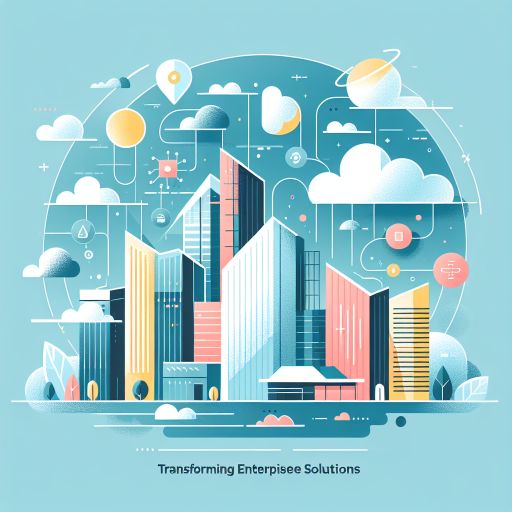Introduction to Digital Transformation and Its Significance
Digital transformation refers to the process by which organizations integrate digital technology into all areas of their operations, fundamentally changing how they operate and deliver value to customers. It leverages various technological advancements such as cloud computing, artificial intelligence, big data, and the Internet of Things (IoT) to drive efficiency, innovation, and competitiveness.
The significance of digital transformation can be observed across different sectors, including finance, healthcare, manufacturing, and retail. These industries utilize digital tools and solutions to streamline processes, enhance customer experiences, and develop new business models. For example, banks use big data analytics to offer personalized financial services, while healthcare providers employ telemedicine and electronic health records to improve patient care.
Cloud computing plays a pivotal role in digital transformation by providing scalable and flexible IT resources over the internet. It replaces traditional on-premises infrastructure, allowing organizations to save costs, quickly deploy applications, and innovate at a faster pace. Cloud-based solutions enable businesses to access powerful computing resources on-demand, facilitating data storage, analysis, and machine learning applications.
Moreover, cloud computing supports collaboration and remote work by allowing employees to access the necessary tools and information from anywhere, thus boosting productivity and workforce agility. Enterprises can also scale their operations seamlessly to meet changing demands, ensuring business continuity and resilience.
The shift to digital business models often involves cultural and organizational changes. Companies must foster a culture of innovation, encouraging employees to adopt new technologies and workflows. Leadership commitment is crucial to navigate the transformation journey, align digital strategies with business objectives, and allocate resources effectively.
In conclusion, digital transformation is an indispensable strategy for modern enterprises striving to maintain a competitive edge in a rapidly evolving technological landscape. By embracing digital technologies like cloud computing, organizations can enhance their operational efficiency, deliver superior customer experiences, and unlock new growth opportunities.
Sabir Khan: A Pioneering Visionary in Cloud Computing
Sabir Khan has been a pivotal figure in the evolving landscape of cloud computing, recognized for his pioneering vision and transformative impact on enterprise solutions. His contributions to this field have not only revolutionized the way organizations manage their IT infrastructure but have also paved the way for innovative approaches to digital transformation.
Early Career and Education:
Sabir Khan’s journey in the tech industry began with a robust academic background. He earned a degree in Computer Science from the Massachusetts Institute of Technology (MIT), which provided a solid foundation for his future endeavors. His early exposure to the burgeoning field of cloud computing during his academic years piqued his interest and set the stage for his career.
Professional Milestones:
Upon graduation, Khan joined leading technology firms where he gained extensive experience in software development and IT infrastructure management. His roles at companies like Microsoft and Google allowed him to deepen his understanding of cloud computing and its potential to transform businesses. During his tenure at these organizations, he was instrumental in the development and deployment of several large-scale cloud-based projects, which demonstrated his forward-thinking approach and technical expertise.
Innovative Contributions:
One of Sabir Khan’s notable contributions to cloud computing is his work on creating scalable, secure, and cost-effective cloud infrastructure solutions. His efforts have focused on optimizing the use of cloud resources, ensuring data security, and enhancing the performance of cloud-based applications. These innovations have been critical in addressing the challenges associated with cloud adoption and have significantly lowered the entry barriers for organizations looking to migrate to the cloud.
Thought Leadership and Advocacy:
Khan is also a respected thought leader in the tech community. He has authored numerous articles and whitepapers on cloud computing, advocating for the widespread adoption of cloud technologies. Through his speaking engagements at international conferences and symposiums, he has shared insights and best practices that have influenced industry standards and policies. His advocacy efforts have played a crucial role in demystifying cloud computing and highlighting its strategic advantages for businesses of all sizes.
Leadership Roles:
In addition to his technical contributions, Sabir Khan has held several leadership positions where he has shaped the strategic direction of cloud services. As a Chief Technology Officer (CTO) at various startups and established firms, he has overseen the implementation of comprehensive cloud strategies that align with business objectives. His leadership style emphasizes collaboration, innovation, and a customer-centric approach, which has earned him recognition as a visionary leader in the field.
Overall, Sabir Khan’s contributions to cloud computing and enterprise solutions have been instrumental in driving digital transformation across numerous sectors. His work continues to influence the development of cutting-edge technologies and the evolution of IT infrastructure, making him a key figure in the ongoing advancement of cloud computing.
Early Contributions and Innovations
Sabir Khan’s journey into the world of cloud computing began with his early contributions and innovations, which have left a lasting impact on the industry. Understanding his initial steps helps to appreciate how his work has shaped modern enterprise solutions.
One of Khan’s earliest contributions was his involvement in the development of Virtual Machine (VM) technology. By working on projects that aimed to create more efficient virtualization techniques, he helped to pave the way for the cloud infrastructure we are familiar with today. His work focused on optimizing VM performance, reducing overhead, and improving scalability, all of which are critical components of modern cloud services.
Beyond virtualization, Khan also played a significant role in enhancing data storage solutions. He was part of teams that developed innovative distributed storage systems, which directly addressed issues of data redundancy, availability, and security. These systems enabled more reliable and cost-effective data management solutions, crucial for the growth of cloud computing.
Another key area of Khan’s innovation was in network optimization and orchestration. His contributions in developing algorithms and protocols that improved data transfer speeds and reliability were instrumental. These advancements allowed for more seamless integration of cloud services across various geographic locations, supporting the global scalability of enterprise solutions.
Moreover, Khan was influential in the adoption of containerization technologies. He foresaw the potential of containers to revolutionize software deployment and management. By advocating for and contributing to the development of container orchestration tools, such as Kubernetes, he enabled enterprises to adopt more flexible and efficient cloud architectures.
In addition to technological innovations, Khan was known for his emphasis on research and collaboration. He authored numerous papers and participated in conferences that brought together experts from academia and industry. This collaborative spirit helped to foster a community focused on pushing the boundaries of what cloud technology could achieve.
Khan’s early innovations laid a robust foundation for the widespread adoption of cloud computing. His technical contributions and thought leadership played a pivotal role in transforming enterprise IT infrastructure, setting a precedent for continuous improvement and innovation in the field.
Transforming Enterprise Solutions Through Cloud Computing
Sabir Khan has played a pivotal role in transforming enterprise solutions through the integration of cloud computing technologies. His work has led to the modernization of legacy systems, enhancement of business agility, and significant cost reductions for organizations willing to embrace the cloud.
One of the primary contributions of Sabir Khan in this domain is his advocacy for cloud-first strategies. By promoting a shift from traditional on-premises infrastructure to cloud-based environments, Khan has enabled enterprises to unlock new levels of scalability and flexibility. These attributes are essential in today’s fast-paced business world, where the ability to quickly respond to market changes can determine organizational success.
Khan’s impact is also evident in his efforts to address common misconceptions about cloud computing. Through extensive research and expert consultations, he has highlighted the security and compliance advantages of cloud solutions. This work has helped alleviate concerns around data privacy and regulatory compliance, encouraging more businesses to transition to the cloud confidently.
Moreover, Sabir Khan has been instrumental in the development and popularization of hybrid cloud models. These models allow enterprises to maintain a balance between public and private clouds, optimizing both performance and cost. By strategically combining different cloud environments, organizations can achieve enhanced load balancing, greater data availability, and improved disaster recovery capabilities.
Khan’s contributions extend to the enhancement of enterprise software and infrastructure. By leveraging cloud-native technologies such as microservices, containers, and serverless computing, he has guided businesses in building more resilient, scalable, and maintainable applications. These advancements facilitate quicker updates, shorter time-to-market, and more efficient resource allocation.
Another critical area where Sabir Khan has made a significant impact is in the democratization of advanced technologies. By advocating for cloud-based solutions, he has enabled smaller enterprises to access high-performance computing, artificial intelligence, and machine learning capabilities that were previously the domain of large corporations. This accessibility has leveled the playing field, fostering innovation across industries.
Ultimately, Sabir Khan’s efforts in transforming enterprise solutions through cloud computing have laid the groundwork for a more agile, efficient, and innovative business landscape. His influence continues to be felt as enterprises increasingly adopt cloud technologies to stay competitive and future-proof their operations.
Case Studies of Sabir Khan’s Impact on Major Corporations
Sabir Khan’s impact on cloud computing and enterprise solutions can be clearly observed through his work with several major corporations. His initiatives in digital transformation have introduced efficiencies, cost savings, and innovation across various industries.
At a leading financial services company, Khan’s cloud computing strategies were pivotal in transitioning their data infrastructure from on-site servers to a hybrid cloud environment. This migration led to significant reductions in operational costs and enhanced data security. Furthermore, the agility provided by cloud computing allowed the company to innovate rapidly and meet market demands more efficiently.
In the healthcare sector, Khan’s work with a prominent hospital network revolutionized their patient data management systems. By implementing a cloud-based electronic health records (EHR) system, the institution achieved real-time accessibility of patient data across multiple facilities. The cloud solution also ensured compliance with stringent healthcare regulations and improved the overall quality of patient care.
- Implementation of a cloud-based EHR system
- Enhanced data security and compliance
- Improved patient care through real-time data access
Khan also played a crucial role in the digital transformation of a global retail corporation. Under his guidance, the company adopted cloud-based inventory management and customer relationship management (CRM) systems. This shift enabled the retailer to optimize supply chain operations, reduce stockouts, and personalize customer interactions through data-driven insights.
The retail corporation experienced the following benefits:
- Optimized supply chain operations
- Reduced inventory stockouts
- Personalized customer experiences via data analytics
In the technology sector, a major software development company sought Khan’s expertise for their cloud transition. His approach involved leveraging scalable cloud platforms to handle software development and deployment processes. As a result, the company achieved faster development cycles and reduced time-to-market for new products, enhancing their competitive edge.
Throughout these instances, Khan’s strategies demonstrated the profound impact of cloud computing on enterprises. His emphasis on scalable solutions, data security, and regulatory compliance ensured that each corporation not only embraced digital transformation but also thrived in the evolving technological landscape. The success stories from these corporations serve as a testament to Sabir Khan’s influential role in advancing cloud computing and enterprise solutions.
Challenges and Overcoming Barriers in Cloud Adoption
Cloud adoption is a multifaceted process that presents several challenges for organizations regardless of their size or industry. Sabir Khan’s journey in driving digital transformation includes addressing these challenges and formulating strategies to overcome them effectively.
Key Challenges in Cloud Adoption
Organizations face several obstacles when transitioning to cloud-based systems. These challenges can hinder the ability to fully leverage cloud computing benefits. Some of the primary challenges include:
- Security and Compliance: Ensuring data privacy and compliance with regulatory requirements is one of the biggest concerns for organizations migrating to the cloud.
- Cost Management: Cloud services can lead to unexpected expenses if not managed properly. Organizations often struggle with optimizing costs.
- Integration with Existing Systems: Migrating legacy systems to cloud environments can be complex and resource-intensive.
- Skill Gaps: There is a noticeable shortage of skilled professionals capable of managing and optimizing cloud solutions.
Strategies to Overcome Barriers
Sabir Khan has been instrumental in devising strategies to address these challenges. These strategies revolve around strengthening security frameworks, implementing cost-management practices, ensuring seamless integration, and addressing skill gaps through training and development. Key strategies include:
- Enhanced Security Measures: Implementing advanced security protocols and compliance measures to protect sensitive data in the cloud.
- Cost Optimization Tools: Utilizing cloud cost-management tools and practices to monitor and control expenses effectively.
- Hybrid Cloud Solutions: Adopting hybrid cloud environments to facilitate the integration of legacy systems with new cloud-based solutions.
- Training Programs: Developing comprehensive training programs to upskill the workforce and bridge the skill gap in cloud technologies.
Impact on Organizations
The implementation of these strategies has allowed organizations to overcome significant barriers in cloud adoption. The tangible benefits include enhanced security, optimized costs, successful integration of existing systems, and a more skilled workforce. Here’s a summary table of the impact on certain areas:
| Area | Impact |
|---|---|
| Security and Compliance | Improved data security and regulatory compliance |
| Cost Management | Reduced unpredictable expenses |
| Integration | Smoother migration of legacy systems |
| Skill Development | Higher proficiency in cloud technologies |
These measures, spearheaded by Sabir Khan, have provided a roadmap for countless organizations to navigate the complex landscape of cloud adoption successfully, ensuring a smooth and efficient transition to cloud-based solutions.
Future Trends and Predictions in Cloud Computing
The future of cloud computing is a subject of significant interest within the technology sector, as it promises to drive substantial changes across industries. Sabir Khan, having played a pivotal role in its evolution thus far, provides insights that are particularly valuable when anticipating future trends and developments.
Artificial Intelligence (AI) and Machine Learning (ML) Integration: One of the most anticipated trends is the integration of AI and ML into cloud services. Cloud providers are increasingly incorporating AI and ML capabilities to offer more advanced analytics, predictive maintenance, and personalized user experiences. This integration is expected to enhance the efficiency of cloud-based applications and open new avenues for innovation.
Edge Computing: Edge computing is gaining traction as a complement to cloud computing. By processing data closer to the source of generation, edge computing reduces latency and bandwidth use. This trend is particularly important for applications requiring real-time processing, such as autonomous vehicles and IoT devices. The synergy between cloud and edge services is predicted to bring about robust, decentralized processing frameworks.
Hybrid and Multi-Cloud Environments: The adoption of hybrid and multi-cloud strategies is another key trend. Organizations are increasingly leveraging multiple cloud services to avoid vendor lock-in and achieve better flexibility and scalability. Hybrid cloud setups, combining on-premises infrastructure with cloud resources, provide a balanced approach that caters to various compliance and workload requirements.
Serverless Computing: Serverless architectures, which allow developers to run code without provisioning or managing servers, are expected to become more prevalent. This model offers scalable, cost-efficient solutions that abstract the underlying infrastructure, enabling developers to focus more on application development. Major cloud providers are investing heavily in expanding their serverless offerings.
Security and Compliance Enhancements: As the digital landscape evolves, so do the threats. Future advancements in cloud computing will likely see a heightened focus on security and compliance. This includes the development of more sophisticated encryption techniques, automated compliance tools, and zero-trust security models to safeguard data and applications.
Quantum Computing: Although still in its nascent stages, quantum computing represents a future frontier. It holds the potential to solve complex problems beyond the capability of classical computers. As cloud providers begin to explore quantum computing, it is anticipated to eventually become available as a service, bringing unprecedented computational power to a broader audience.
In summary, while the future of cloud computing is replete with exciting advancements, it also presents new challenges and complexities. Sabir Khan’s contributions and foresight have paved the way for many of these developments, establishing a foundation upon which future innovations will build. As the industry continues to evolve, embracing these emerging trends will be crucial for maintaining competitive advantage and fostering technological growth.
Conclusion: The Lasting Legacy of Sabir Khan
The realm of cloud computing and enterprise solutions has seen remarkable advancements, with Sabir Khan standing out as a significant influencer whose work continues to resonate across industries. His pioneering efforts and strategic implementations have left an indelible mark, establishing foundational shifts that promise sustained progress in digital transformation.
One of the lasting impacts of Khan’s contributions is the elevation of cloud computing from a peripheral technology to a central element of modern enterprise infrastructure. By advocating for a hybrid approach that combines private and public clouds, Khan facilitated a balance between cost efficiency and security. This strategy provided a flexible framework that enterprises could adopt according to their unique needs, thus broadening the accessibility and scalability of cloud solutions.
Additionally, Khan’s emphasis on automation and artificial intelligence within cloud environments substantially improved the efficiency and capabilities of organizational processes. His work championed the integration of AI in areas such as predictive analytics, enhancing the ability of businesses to anticipate and respond to market trends proactively. This has not only elevated operational efficiencies but also empowered enterprises to make data-driven decisions.
The following table outlines some key areas where Sabir Khan’s impact has been particularly profound:
| Area of Impact | Description |
|---|---|
| Hybrid Cloud Strategies | Balanced deployment of private and public clouds, optimizing cost and security. |
| AI Integration | Incorporation of AI for predictive analytics and automation, driving efficiency. |
| Enterprise Scalability | Enhanced the scalability of enterprise solutions, accommodating growth and flexibility. |
| Data-Driven Decision Making | Empowerment of businesses through enhanced data analytics capabilities. |
Sabir Khan’s forward-thinking initiatives have not only transformed current enterprise operations but also set a precedent for future innovations. His approach emphasizes the importance of continuous improvement and adaptation, ensuring that cloud computing remains a dynamic and integral part of the digital transformation landscape.
In sum, Khan’s legacy is one of visionary leadership and practical implementation, providing a robust foundation upon which future advancements will undoubtedly build. As businesses continue to navigate the complexities of digital transformation, the principles and strategies pioneered by Sabir Khan will guide their journey toward greater efficiency, security, and innovation.









